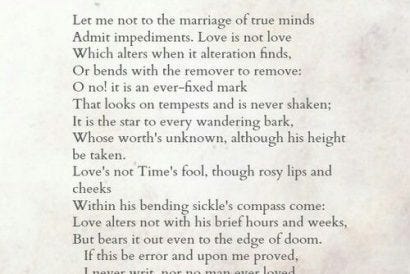A product has been added to the basket
How to Write a Sonnet

How to Write a Sonnet

Nothing says ‘I Love You’ more than the handwritten word, so this Valentine’s Day Pen Heaven have dipped their quill in ink to present their top tips on how to write a (love) Sonnet. Around for centuries, the Sonnet originated in Italy (known as a Petrarchan sonnet) and follows a strict rhyme scheme of fourteen lines, usually offering two sides that form the entirety of an ‘argument’.
Traditionally written in iambic pentameter the first known sonnets in English were written by Sir Thomas Wycott, Henry Howard and the Earl of Surrey in the early 16th Century. Rising to fame thanks to William Shakespeare and his love of, well, love, the sonnet became the go-to medium for divulging gestures from the heart.
The Shakespearean sonnet, composed of 3 quatrains and a concluding two-line couplet, is often thought of as one of the most creative and romantic ways to express your deepest feelings. As it’s often easier to channel how we feel through our writing, Pen Heaven have put together their quick-fire tips to help you transform your passion into words, allowing your expressions to flow with the gentle rhythm of a sonnet.
Get Inspired
Pick up some books and poetry from revered writers. Grab a feathered quill and notebook and feel the sense of history as you channel your inner Shakespeare.
“Music breeds its own inspiration. You can only do it by doing it. You may not feel like it, but you push yourself. It’s a work process. Or just improvise. Something will come.” - Burt Bacharach
Emotions & Feelings

The first question you need to ask yourself is what message do you want to convey and to whom? Keep it simple and concise. Write down all the words that describe how you feel about your chosen muse, as many as possible, as these will be paramount when it comes to creating the rhyme.
“Poetry is a solitary process. One does not write poetry for the masses. Poetry is a self—involved, lofty pursuit.” - Patti Smith
Make it Personal
It may seem like an obvious one, but adding a bit of nostalgia to your sonnet will make it more desirable. Think of the first time your eyes locked, your first date, your first kiss. Was it love at first sight? This will confirm the authenticity of your lyrics and your words will hold more meaning.
"I always think about personal experience when writing lyrics for a song because the emotion is so much more real if you've been in that situation before. Never give up on a song if you're not feeling it, it will come to you eventually! No ideas are ever wasted, just keep coming back to it and trying something new." - Singer/Songwriter, Daisy Day, Daisydaymusic.com
Comparisons
“Shall I compare thee to a summer day?” Who could ever forget that Shakespeare line, taken from one of his most widely read sonnets, Sonnet 18. The apple of your eye has clearly had a significant impact on your life, so it is time to start comparing. What was your life like before you met, in contrast to the joyful days spent together now? How does your beloved liken to some of the sweetest/ finest/ greatest things in life? You get the idea.
Tone & Rhythm
The popular pattern for a sonnet is the iambic pentameter, so we would suggest that for its ease - the da-DUM of your heartbeat offers the perfect example of this rhythm. As for the tone, you are writing a love sonnet, so give your romantic side full reign. Just ensure sure your personality shines through!
Practice
Whilst sonnets are quite straightforward to write, don’t be disheartened if your first attempt isn’t of the same calibre as Shakespeare. Instead, practice, practice and practice again. For a final piece of inspiration, enjoy Sonnet 116…
Have you written a sonnet to you loved one? Please share it and offer any further tips you might have in the comments below.











Comments
Very good
Very good